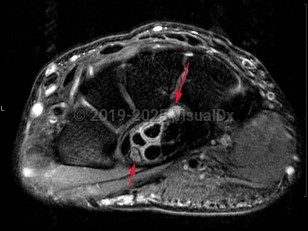Carpal tunnel syndrome - Nail and Distal Digit
See also in: OverviewAlerts and Notices
Important News & Links
Synopsis
Mild carpal tunnel syndrome is typically not associated with dermatologic findings. When long-standing, autonomic nerve dysfunction occurs, resulting in necrotic carpal tunnel syndrome. Dermatologic manifestations will then include bullae, ulcers, hypohidrosis, vasospasm, and Raynaud phenomenon. Nail changes may also occur and may be a clue to diagnosis of carpal tunnel syndrome.
Nail changes are more common in women, with a median age of 54 years. The right hand is more often involved than the left.
There are case reports of carpal tunnel-associated nail changes in children and young adults; however, it is very rare in children. For late stage carpal tunnel syndrome presenting in children, genetic or metabolic causes should be explored, although there are reports of sporadic cases. These include lysosomal storage diseases (familial thickening of the transverse ligament and diabetes mellitus). Other reported causes are repetitive wrist motion, median nerve fibrolipomas or hemangiomas, hemophilia, automutilation, and trauma.
Codes
G56.00 – Carpal tunnel syndrome, unspecified upper limb
SNOMEDCT:
57406009 – Carpal tunnel syndrome
Look For
Subscription Required
Diagnostic Pearls
Subscription Required
Differential Diagnosis & Pitfalls

Subscription Required
Best Tests
Subscription Required
Management Pearls
Subscription Required
Therapy
Subscription Required
Drug Reaction Data
Subscription Required
References
Subscription Required
Last Updated:05/31/2020

